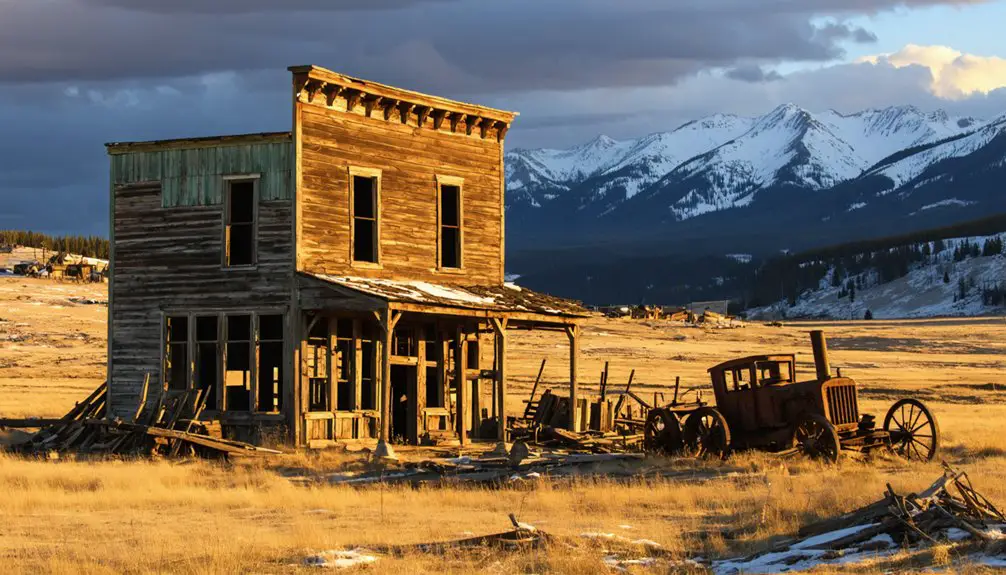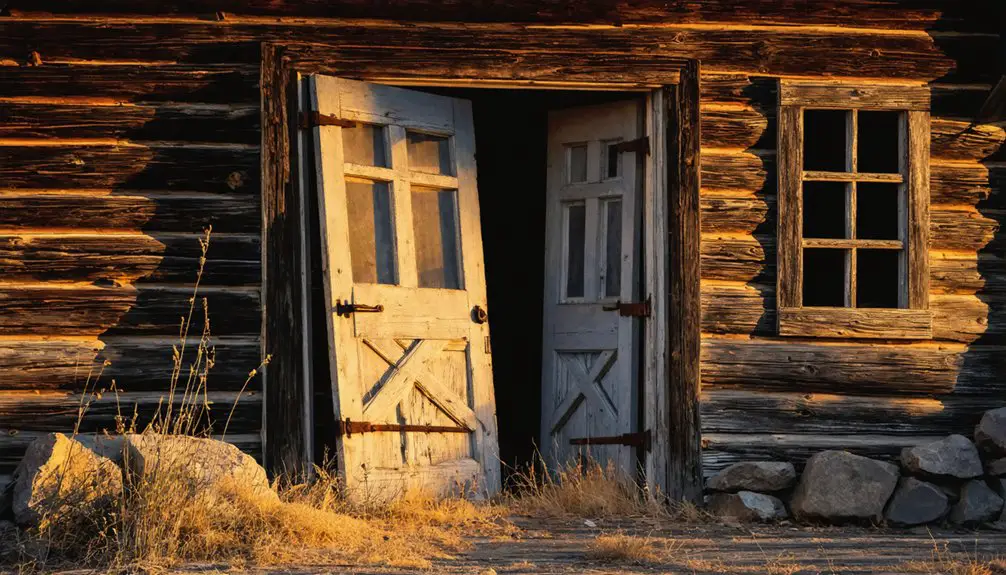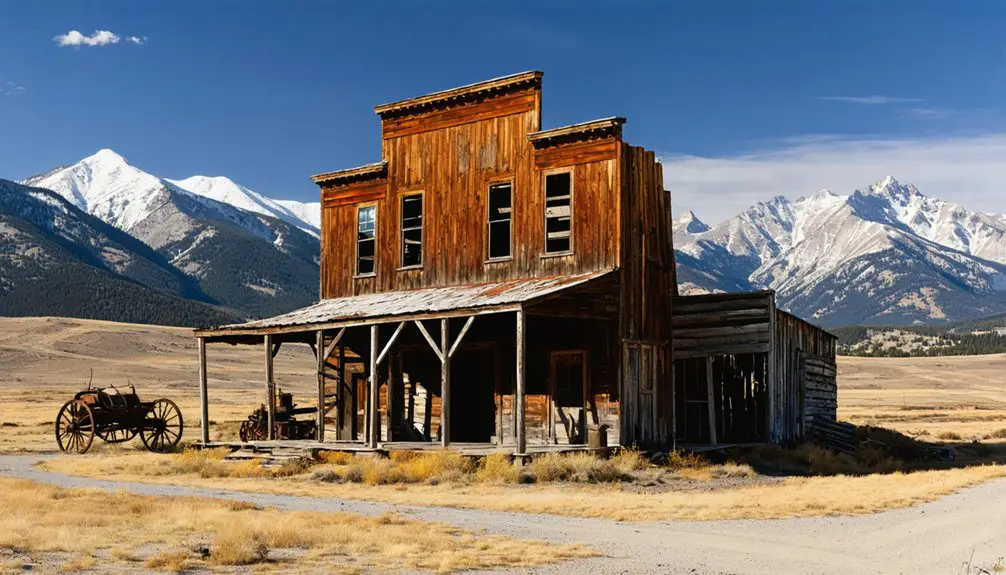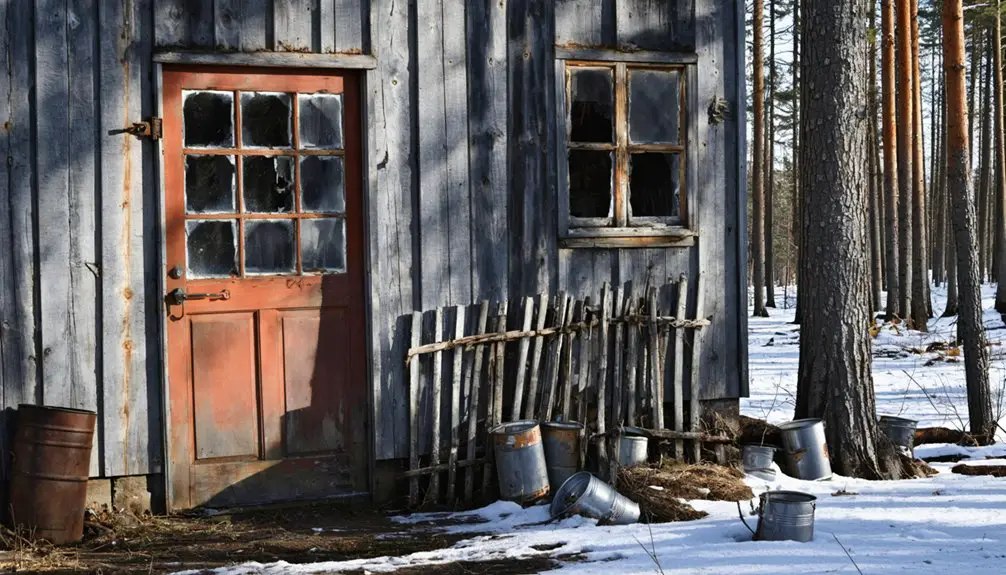You’ll find Rimini nestled in Montana’s Ten Mile Creek Valley, where Irish miners established a bustling silver mining settlement in 1864. The town’s distinctive architecture includes the 1904 schoolhouse, now listed in the National Register of Historic Places, alongside preserved miners’ cabins and mining equipment. During World War II, Rimini transformed into America’s only specialized military dog training facility. Today, this well-preserved ghost town offers a fascinating blend of mining heritage, military history, and architectural treasures to explore.
Key Takeaways
- Originally named Young Ireland, Rimini was established in 1864 as a silver mining town in Montana’s Ten Mile Creek Valley.
- The town peaked at 300 residents in 1890, featuring hotels, saloons, and mines that produced $7 million in minerals.
- During World War II, Rimini served as America’s only specialized training center for military sled and pack dogs.
- The 1904 Schoolhouse remains preserved and is listed in the National Register of Historic Places.
- Visitors can explore over 100 former mine sites and restored miners’ cabins in the surrounding national forest.
The Birth of Young Ireland and Its Evolution to Rimini

When Irish miners discovered rich silver lodes in Montana’s Ten Mile Creek Valley in 1864, they established a settlement that would become known as Young Ireland.
The community’s Irish heritage shaped its early identity, serving as a central hub for nearly 100 silver mines nestled between Red Mountain and Lee Mountain.
You’ll find that the settlement’s strong community structure reflected the cultural bonds of its immigrant founders.
Mining Boom and Economic Legacy
The discovery of the Lee Mountain Lode in 1864 and Eureka Mine in 1865 marked the start of Rimini’s meteoric rise in Montana’s mining industry.
While early mining techniques were hampered by transportation challenges, the 1885 Northern Pacific spur line revolutionized ore shipments, enabling weekly deliveries of 400 tons to Wickes smelter by 1891.
You’ll find Rimini’s peak reflected in its bustling population of 300 residents by 1890, complete with hotels, stores, and entertainment venues.
The district’s economic fluctuations yielded approximately $7 million in silver, lead, zinc, copper, and gold by 1928.
Like many mining operations of the era, the miners relied heavily on hydraulic mining equipment to extract valuable minerals from the surrounding hillsides.
The Porphyry Dike Mine‘s gold operations helped sustain the town through the devastating 1893 silver crash, though environmental concerns eventually forced its closure in 1926.
Life in a Montana Mining Town

Nestled in Montana’s Ten Mile Creek Valley, Rimini’s social fabric centered around a tight-knit community of mainly Irish miners who’d transformed their settlement from “Young Ireland” into a self-sustaining town.
The daily routines revolved around the mines, where workers extracted up to 400 tons of ore weekly, shipping their hauls to smelters in Wickes and East Helena.
You’d have found the town bustling with community gatherings at multiple saloons, gambling houses, and pool halls.
Essential services included hotels, boarding houses, a physician’s office, and a sawmill. The local schoolhouse educated children while a church tended to spiritual needs.
From War Dogs to Ghost Town: Camp Rimini’s Military Chapter
During World War II, Rimini’s quiet mining landscape transformed dramatically as the former Civilian Conservation Corps facility became Camp Rimini, America’s only specialized training center for military sled and pack dogs.
From 1942 to 1944, you’d have witnessed over 500 dogs training alongside their handlers under the Quartermaster Corps, preparing for vital missions in harsh winter environments from Newfoundland to Europe.
The camp’s strategic location near other Montana military sites made it ideal for top-secret operations, including planned parachute drops into Norway.
Though Camp Rimini’s training legacy helped shape military dog programs, its prominence faded after the war.
Today, you’ll find only traces of this unique facility where military dogs once trained, as Rimini settled back into its mining town roots before ultimately becoming a ghost town.
Preserved Heritage and Modern-Day Adventures

While many ghost towns fade into obscurity, Rimini’s rich architectural heritage lives on through its remarkably preserved late 19th-century buildings.
Unlike forgotten ghost towns, Rimini stands as a testament to architectural preservation, its 19th-century buildings defying time.
You’ll discover authentic false-front commercial structures where original log frames peek through carefully maintained facades. The centerpiece 1904 Schoolhouse, now listed in the National Register of Historic Places, serves as your gateway to community gatherings.
You’re free to explore over 100 former mine sites while hiking the surrounding Helena-Lewis and Clark National Forest. The town once flourished with silver and zinc mining until resources became scarce.
Stop by restored miners’ cabins, now weekend retreats, or visit the historic Moose Creek Ranger Station.
Today’s heritage tourism blends architectural preservation with outdoor adventure, as you’ll find both permanent residents and seasonal visitors sharing Rimini’s peaceful mountain setting along Ten Mile Creek Valley.
Frequently Asked Questions
Are There Any Paranormal Activities Reported in Rimini’s Abandoned Buildings?
You won’t find verified reports of ghost sightings or haunted buildings in Rimini’s abandoned structures, though nearby Montana mining towns have documented paranormal activity. Local lore remains mostly anecdotal without concrete evidence.
What Happened to the Mining Equipment After the Mines Closed?
You’ll find most mining equipment was abandoned in place after 1926, deteriorating near crumbling structures. Some pieces remain as historical preservation sites, while others rusted away without maintenance or restoration.
How Dangerous Is It to Explore the Old Mine Tunnels?
Your heart will stop beating before you know what hit you. Mine safety is non-existent – tunnel exploration means risking deadly gas, cave-ins, toxic chemicals, unstable ground, and getting fatally lost underground.
Can Visitors Pan for Gold in Ten Mile Creek Today?
You can do gold panning in Tenmile Creek with basic tools like pans and sluice boxes, but creek access is restricted. You’ll need permits for dredging, and you can’t dig along banks.
Where Did Most of Rimini’s Residents Relocate After the Town Declined?
When Rimini’s glory days faded, you’ll find most resident stories lead 12 miles east to Helena, Montana. Some folks spread to nearby Lewis and Clark County towns, while others kept summer cabins in Rimini.
References
- https://en.wikipedia.org/wiki/Rimini
- https://www.legendsofamerica.com/mt-rimini/
- https://www.mountain-home.com/blog/vacation-planning/guide-montana’s-ghost-towns
- https://montanahistoriclandscape.com/2023/07/28/rimini-a-ghost-town-in-the-helena-lewis-and-clark-national-forest/
- https://www.mtghosttowns.com/rimini
- https://www.instagram.com/p/C4dIawXPHnh/
- https://visitmt.com/listings/general/ghost-town/rimini
- https://kids.kiddle.co/Rimini
- https://catcountry1029.com/not-quite-a-ghost-town-check-out-rimini-montana/
- https://discoveringmontana.com/ghost-towns/rimini/



